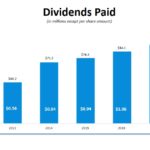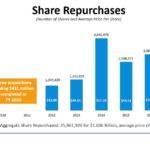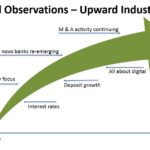Contents
Summary
- Jack Henry & Associates is a leading provider of technology solutions and payment processing services primarily for financial services organizations.
- Despite various general downward industry trends there are sufficient upward industry trends which provide an opportunity for JKHY to continue to grow.
- JKHY returns value to shareholders through the distribution of dividends, share repurchases, and acquisitions.
- The company has no long-term borrowings.
- JKHY consistently generates strong Free Cash Flow.
- JKHY established its dividend policy in 1990 and the dividend has increased every fiscal year since its inception.
Introduction
In my March 24, 2019 Copart, Inc. (CPRT) post I looked at a company which certainly is not a household name like the vast majority of companies I analyze. Jack Henry & Associates, Inc. (JKHY) is another company which does not typically hit most investor’s ‘radar’.
I favor investing in companies which have, among other things, a track record of positive Free Cash Flow and a low level of debt. My rationale for investing in such companies is that I have observed individuals/companies who/which have employed what I have perceived to be elevated levels of debt. Some have most certainly been successful but from personal observation during my 30+ year banking career, however, excessive levels of debt have typically resulted in less than a desired outcome.
This is why JKHY is a company which has attracted my interest! Looking at JKHY’s results for the past several fiscal years I see it:
- reported $0 long-term debt at the end of Q2 2019 other than non-current deferred revenues, non-current deferred income tax liability, and other long-term liabilities – the non-current deferred income tax liability represents ~88% of JKHY’s long-term debt;
- has consistently generated positive Free Cash Flow (FY 2009 – FY2018: 150, 139, 181, 185, 211, 230, 228, 201, 209, and 262 – expressed in millions);
- has a Gross Margin % in the low 40s and an Operating Margin in the mid 20s;
- established its dividend policy in 1990 and the dividend has increased every fiscal year since inception.
Historical Stock Performance
While JKHY is listed on the NASDAQ, the company’s historical stock performance is compared to the S&P 500 in its FY2018 Annual Report. I provide the link below so you can set your own metrics to see the extent to which JKHY’s stock has outperformed the S&P500.
Business Overview
JKHY is a leading provider of technology solutions and payment processing services primarily for financial services organizations. Its solutions serve over 9,000 customers and are marketed and supported through three primary brands.
- Jack Henry Banking supports banks, ranging from community banks to multi-billion-dollar institutions with assets up to $50B, with information and transaction processing solutions.
- Symitar is a leading provider of information and transaction processing solutions for credit unions of all sizes.
- ProfitStars provides highly specialized products and services that enable financial institutions of every asset size and charter, and diverse corporate entities outside the financial services industry, to mitigate and control risks, optimize revenue and growth opportunities, and contain costs.
Its integrated solutions are available for in-house or outsourced delivery.
The high quality of JKHY’s solutions and high service standards foster long-term customer relationships and help it attract prospective customers.
Through internal product development, disciplined acquisitions, and alliances with companies offering niche solutions that complement JKHY’s proprietary solutions, JKHY regularly introduces new products and services which generate new cross-sales opportunities across its three primary business brands.
JKHY provides compatible computer hardware for its in-house installations and secure processing environments for its outsourced solutions.
JKHY has 2 primary revenue streams.
Services and Support which includes:
- “Outsourcing and cloud” fees that predominantly have contract terms of 5+ years;
- “Product delivery and services” revenue which includes revenue from the sales of licenses, implementation services, consulting, and hardware;
- “In-house support” revenue which is composed of maintenance fees and which primarily contain annual contract terms.
Processing Services and Support Processing revenue includes:
- “Remittance” revenue from payment processing, remote capture and automated clearing house (ACH) transactions;
- “Card” fees, including card transaction processing and monthly fees;
- “Transaction and digital” revenue which includes transaction and mobile processing fees.
JKHY has 4 reportable segments: Core, Payments, Complementary, and Corporate and Other.
Key Customer Strategies, for which JKHY offers solutions, include:
- Digital Experience - Banks and Credit Unions need a comprehensive digital strategy in order to compete;
- Deposit Gathering – Financial institutions (FIs) are challenged to find sufficient deposits to fund ongoing lending opportunities;
- Commercial Services - FIs require tools to expand their relationships with larger commercial customers for the purpose of pursuing loan and deposit growth opportunities;
- Fraud and Security;
- Outsourcing;
- Efficiency Improvements - Most FIs are looking to improve processes, save time, and mitigate risk associated with manual processes;
- Payments - The payments landscape continues to evolve and JKHY’s clients need a suite of solutions including bill pay, credit, debit, ACH, real time, and access to Zelle and The Clearing House.
Zelle is a convenient way to send and receive money to almost anyone with an eligible U.S.-based bank account using their email address or U.S. mobile phone number.
A clearing house is a financial institution formed to facilitate the exchange (i.e., clearance) of payments, securities, or derivatives transactions. The clearing house stands between two clearing firms (aka member firms or participants).
JKHY returns value to shareholders through the distribution of dividends, share repurchases, and acquisitions.
Source: JKHY 2018 - Analyst Conference Presentation - May 7, 2018
JKHY has supplemented its organic growth with 31 strategic acquisitions since the end of fiscal 1999 and the end of FY2018. Three of these acquisitions were completed in the last 3 years.
Industry Overview
Jack Henry Banking primarily serves commercial banks and savings institutions with up to $50B in assets. According to the Federal Deposit Insurance Corporation (“FDIC”), there were approximately 5,630 commercial banks and savings institutions in this asset range as of December 31, 2017. Jack Henry Banking supports over 1,060 of these banks with its core information processing platforms and complementary products and services.
Symitar serves credit unions of all asset sizes. According to the Credit Union National Association (“CUNA”), there were more than 5,680 domestic credit unions as of December 31, 2017. Symitar supports nearly 830 of these credit unions with core information processing platforms and complementary products and services.
ProfitStars serves financial services organizations of all asset sizes and charters and other diverse corporate entities. ProfitStars supports over 9,000 institutions with specialized solutions for generating additional revenue and growth, increasing security, mitigating operational risks, and controlling operating costs.
Source: JKHY 2018 - Analyst Conference Presentation - May 7, 2018
The FDIC reports the number of commercial banks and savings institutions declined 20% from the beginning of calendar year 2013 to the end of calendar year 2017. This has been due primarily to mergers.
While the number of banks declined at a 4% compound annual rate during this period, aggregate assets have increased at a compound annual rate of 4% and totaled $16.2T as of December 31, 2017.
There were 5 new bank charters issued in calendar year 2017, compared to 0 in the 2016 calendar year.
The number of mergers decreased 8% from 2016 to 2017.
CUNA reports the number of credit unions declined 18% from the beginning of calendar year 2013 to the end of calendar year 2017. The number of credit unions declined at a 4% compound annual rate during this period but aggregate assets increased at a compound annual rate of 6% and totaled $1.4T as of December 31, 2017.
The market for companies providing technology solutions to financial services organizations is competitive and significant consolidation has occurred for over a decade and is expected to continue. Some competitors have longer operating histories, larger customer bases, and greater financial resources.
The principal competitive factors affecting the market for technology solutions include product/service functionality, price, operating flexibility and ease-of-use, customer support, and existing customer references.
Jack Henry Banking and Symitar compete with large vendors that provide information and transaction processing solutions to banks and credit unions, including Fidelity National Information Services, Inc.; Fiserv, Inc.; and Finastra.
ProfitStars competes with an array of vendors that provide niche solutions to financial services organizations and corporate entities.
Q2 2019 Results and Guidance
JKHY released Q2 results on February 5, 2019 in which reported an 8% increase in Total Revenue on a GAAP basis and a 9% increase on a non GAAP basis; an adjustment was made for deconversion fees. Reported consolidated operating margins were down from 24% in Q2 2017 to 23% in Q2 2018. Two headwinds impacted operating margins.
- the additional cost of processing debit card customers as JKHY transitioned more to its new payments platform;
- the additional cost for the employee pay-for-performance plan funded with a portion of the savings from the Tax Cuts Job Act (TCJA).
In previous conference calls, management provided some high-level insights into its long-term plans regarding the TCJA. Shortly after the new tax program went into effect, management announced:
- a significant increase in its quarterly dividend ($0.31/share/quarter increased to $0.37/share/quarter);
- a voluntary incentive plan which provided a large subset of its longer tenured employees the option to leave the company with a significant financial reward.
In the voluntary incentive plan decision making process, management projected a ~$8 million Q4 2018 expense as a result of this program. JKHY’s voluntary turnover rate, however, runs well below the industry average and management saw the same trend reflected in the results of the special incentive program. Many fewer people took advantage of the program than expected and the Q4 severance charge ended being a little more than $3 million.
Given these results, management chose to use some of the TCJA tax savings to implement several long-term programs for the benefit of its employees.
In August 2018, an improved 401K offering and several components to a significantly enhanced bonus program were introduced for the benefit of all employees. These bonus program changes are pay-for-performance plans which are consistent with the company’s corporate culture. The purpose of those changes was to help JKHY attract and retain strong talent.
In regards to deconversion fees, this is a fee that is imposed even if you live up to all of your contract terms yet simply wish to end your relationship at the end of the contract term; it will cost you a lump sum not to continue with your current vendor.
Deconversion revenue is largely outside JKHY’s control and very difficult to forecast.
JKHY’s deconversion revenue in Q1 and Q2 is down meaningfully YoY and management expects this trend to continue. While JKHY is negatively impacted in the short-term, it is somewhat of a good problem because it indicates that fewer customers are deconverting and their long-term revenue contribution stays in place. The decline in deconversion means JKHY is not losing as many customers through M&A but it does create challenges in YoY comparisons. This is why the February 5, 2019 Earnings Release has a section in which the Non-GAAP impact of the effects of deconversion fees is disclosed.
On the February 5, 2019 Earnings call, management indicated that it appears Q3 deconversion fees will be down significantly compared to Q3 2018; it appears these fees could be lower by ~$13 million.
Since each million dollars of deconversion fees essentially equates to ~$0.01 of EPS, the consensus EPS estimate has been reduced by ~$0.13 for Q3 and the year.
For FY2019, deconversion fees are expected to be down roughly $20 million.
Despite this headwind, GAAP revenue growth for FY2019 should still end up in the 5.5% - 6% range with operating income essentially flat due to both the decrease in deconversion fees and the additional cost headwinds from JKHY’s payments platform migration and the new pay-for-performance plan.
On a non-GAAP basis, revenue growth should still be in line with the original guidance of ~7% for FY2019.
JKHY’s effective tax rate is projected to be 22% - 23% from the adjusted 28% of FY2018.
Management expects EPS will still ‘be up nicely’ for the year compared to FY2018 after adjusting for the TCJA impact on deferred taxes in FY2018.
Credit Ratings
JKHY has no long-term debt to be rated.
Valuation
JKHY closed at $135.77 on March 22, 2019 and the following calculations are based on this closing price.
For the first 6 months of FY2019 (ending December 31, 2018) JKHY generated diluted EPS of $1.96 versus $2.94 for the same period in the previous fiscal year (as previously noted, the lower EPS reflects the impact to previously presented financial statements as a result of the adoption of ASC 606).
JKHY reported Diluted EPS for FY2014 – FY2018 of $$2.19, $2.59, $3.12, $3.14, and $4.85. In my opinion, I think I am being reasonably conservative if use FY2019 projected earnings of $3.96, especially since JKHY has already generated $1.96 for the first 6 months of the current fiscal year.
On this basis, JKHY’s forward diluted PE would currently be ~34.29; its 5 year average PE is ~28.3 but this is distorted by the ~37 PE in FY2017. If we exclude the elevated PE of FY2017 and just look at the PE for the other years within the 2013 – 2018 timeframe, the historical PE is closer to ~26.8.
Even if JKHY were to turn in remarkable results for the second half of FY2019 and full year diluted EPS came in at $4.75, we would end up with a forward diluted PE of ~28.58 which is still slightly greater than the 5 year average diluted PE.
We see that JKHY’s share price retraced to the low $120s just prior to Christmas 2018. Secondly, we see JKHY’s historical PE of ~26.8. Using this PE and my projected diluted EPS of $3.96, a price close to $106 seems more reasonable.
I strongly suspect that if JKHY’s share price were to retrace to this extent it would not be unreasonable for the Board of Directors to authorize the significant repurchase of shares; the degree to which this share purchase would prop up JKHY’s share price is subject for debate.
Dividend, Dividend Yield, Dividend Payout Ratio
JKHY’s dividend and stock split history can be found here. This segment of the company’s website is not kept current but this Press Release confirms JKHY increased its quarterly dividend $0.37/quarter to $0.40/quarter with the increase taking effect with the mid-March 2019 dividend payment.
The annual $1.60 dividend provides investors with a ~1.2% dividend yield based on the $135.77 March 22nd closing stock price.
Using my reasonably conservative FY2019 projected earnings of $3.96 we have a ~40.4% dividend payout ratio which is slightly higher than the mid 30s for recent years. It is, however, still at a conservative level.
Final Thoughts
I like the company’s business model, track record, and future prospects. I am not, however, prepared to acquire JKHY shares at any price.
I have mentioned in previous posts that current market conditions are such that I expect equity prices, in general, to pullback following the rapid run-up evidenced subsequent to late December.
While JKHY’s stock price has retraced to $135.77 from a high of just under $164 set in early September 2018, the share price would need to retrace to at least ~$115 before my interest in acquiring shares would be piqued; even at $115, JKHY’s forward diluted PE would be ~29 (using $3.96 in diluted EPS for FY2018).
While I mention in the Valuation section of this article that $106 seems ‘more reasonable’, I do not think JKHY’s share price will retrace to this level hence the reason why I would be prepared to revisit JKHY at ~$115.
I wish you much success on your journey to financial freedom.
Thanks for reading!
Note: I sincerely appreciate the time you took to read this article. Please send any feedback, corrections, or questions to [email protected].
Disclaimer: I have no knowledge of your individual circumstances and am not providing individualized advice or recommendations. I encourage you not to make any investment decision without conducting your own research and due diligence. You should also consult your financial advisor about your specific situation.
Disclosure: I do not currently hold a position in JKHY and do not intend to initiate a position within the next 72 hours unless the price drops to the level reflected in the ‘Final Thoughts’ section of this article.
I wrote this article myself and it expresses my own opinions. I am not receiving compensation for it and have no business relationship with any company whose stock is mentioned in this article.







